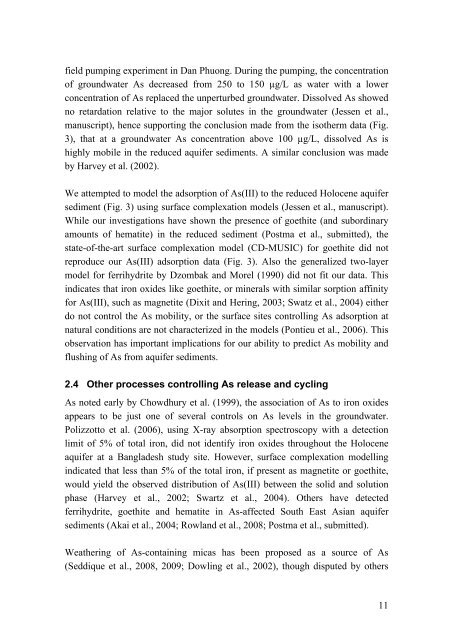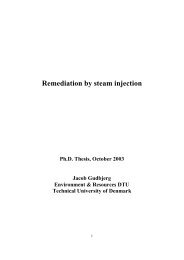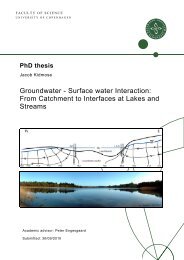Groundwater arsenic in the Red River delta, Vietnam ... - Fiva
Groundwater arsenic in the Red River delta, Vietnam ... - Fiva
Groundwater arsenic in the Red River delta, Vietnam ... - Fiva
You also want an ePaper? Increase the reach of your titles
YUMPU automatically turns print PDFs into web optimized ePapers that Google loves.
field pump<strong>in</strong>g experiment <strong>in</strong> Dan Phuong. Dur<strong>in</strong>g <strong>the</strong> pump<strong>in</strong>g, <strong>the</strong> concentration<br />
of groundwater As decreased from 250 to 150 μg/L as water with a lower<br />
concentration of As replaced <strong>the</strong> unperturbed groundwater. Dissolved As showed<br />
no retardation relative to <strong>the</strong> major solutes <strong>in</strong> <strong>the</strong> groundwater (Jessen et al.,<br />
manuscript), hence support<strong>in</strong>g <strong>the</strong> conclusion made from <strong>the</strong> iso<strong>the</strong>rm data (Fig.<br />
3), that at a groundwater As concentration above 100 μg/L, dissolved As is<br />
highly mobile <strong>in</strong> <strong>the</strong> reduced aquifer sediments. A similar conclusion was made<br />
by Harvey et al. (2002).<br />
We attempted to model <strong>the</strong> adsorption of As(III) to <strong>the</strong> reduced Holocene aquifer<br />
sediment (Fig. 3) us<strong>in</strong>g surface complexation models (Jessen et al., manuscript).<br />
While our <strong>in</strong>vestigations have shown <strong>the</strong> presence of goethite (and subord<strong>in</strong>ary<br />
amounts of hematite) <strong>in</strong> <strong>the</strong> reduced sediment (Postma et al., submitted), <strong>the</strong><br />
state-of-<strong>the</strong>-art surface complexation model (CD-MUSIC) for goethite did not<br />
reproduce our As(III) adsorption data (Fig. 3). Also <strong>the</strong> generalized two-layer<br />
model for ferrihydrite by Dzombak and Morel (1990) did not fit our data. This<br />
<strong>in</strong>dicates that iron oxides like goethite, or m<strong>in</strong>erals with similar sorption aff<strong>in</strong>ity<br />
for As(III), such as magnetite (Dixit and Her<strong>in</strong>g, 2003; Swatz et al., 2004) ei<strong>the</strong>r<br />
do not control <strong>the</strong> As mobility, or <strong>the</strong> surface sites controll<strong>in</strong>g As adsorption at<br />
natural conditions are not characterized <strong>in</strong> <strong>the</strong> models (Pontieu et al., 2006). This<br />
observation has important implications for our ability to predict As mobility and<br />
flush<strong>in</strong>g of As from aquifer sediments.<br />
2.4 O<strong>the</strong>r processes controll<strong>in</strong>g As release and cycl<strong>in</strong>g<br />
As noted early by Chowdhury et al. (1999), <strong>the</strong> association of As to iron oxides<br />
appears to be just one of several controls on As levels <strong>in</strong> <strong>the</strong> groundwater.<br />
Polizzotto et al. (2006), us<strong>in</strong>g X-ray absorption spectroscopy with a detection<br />
limit of 5% of total iron, did not identify iron oxides throughout <strong>the</strong> Holocene<br />
aquifer at a Bangladesh study site. However, surface complexation modell<strong>in</strong>g<br />
<strong>in</strong>dicated that less than 5% of <strong>the</strong> total iron, if present as magnetite or goethite,<br />
would yield <strong>the</strong> observed distribution of As(III) between <strong>the</strong> solid and solution<br />
phase (Harvey et al., 2002; Swartz et al., 2004). O<strong>the</strong>rs have detected<br />
ferrihydrite, goethite and hematite <strong>in</strong> As-affected South East Asian aquifer<br />
sediments (Akai et al., 2004; Rowland et al., 2008; Postma et al., submitted).<br />
Wea<strong>the</strong>r<strong>in</strong>g of As-conta<strong>in</strong><strong>in</strong>g micas has been proposed as a source of As<br />
(Seddique et al., 2008, 2009; Dowl<strong>in</strong>g et al., 2002), though disputed by o<strong>the</strong>rs<br />
11





